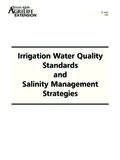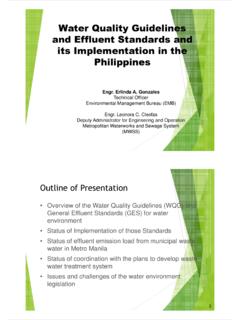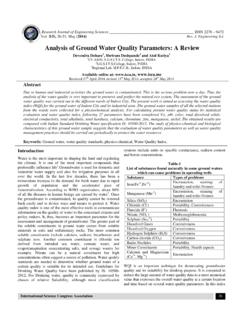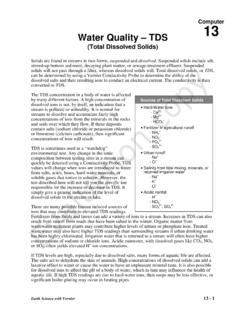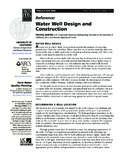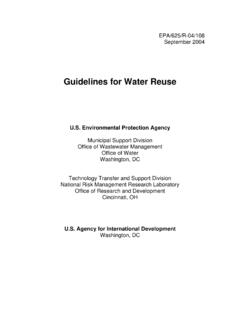Transcription of Water Quality Management Algeria - World Bank
1 Mediterranean Environmental Technical Assistance Program Water Quality Management METAP Secretariat Room H8-133, 1818 H Street NW, Washington DC 20433, USA Tel. (202) 473 2194, Fax (202) 477 1374/1609, E-mail: Website: Algeria Water Availability and Demand Traditional Sources: billion cubic meters (BCM) annually Surface Water : BCM annually. 95 percent of resources in the north. Groundwater: BCM annually. 73 percent of resources in the south. Non-traditional Sources: The use of non-conventional Water resources such as treated wastewater and desalinization is not yet common. Demand: Algeria is a Water -scarce country. Per capita renewable Water resources are 470 cubic meters per year for a population of 29 million. The Water scarcity threshold is 1,000 cubic meters per capita annually. Agricultural irrigation is the primary Water consuming sector followed by the domestic and industrial sectors.
2 Water allocated for irrigation has dropped from 80 percent in 1960 to around 60 percent in 2002. Water Quality and Pollution Sources Salinity levels of surface Water vary between grams per liter (g/l) and g/l with the majority of resources having a salinity of less than 1 g/l. In the north, most groundwater is non-saline with less than 1 g/l salinity. In the south the salinity levels are variable and some sources have high salinity levels of up to 8 g/l. Most Water resources in Algeria are polluted by uncontrolled and untreated municipal wastewater. Eighty-seven percent of the urban population is connected to a sewage network, but most wastewater treatment plants are out of service so untreated sewage is being discharged into natural Water bodies. Industries discharge untreated effluents into natural Water bodies in violation of government regulations.
3 About 200 million cubic meters per year of untreated industrial wastewater is discharged into the environment. Uncontrolled and improperly monitored leaching practices and agricultural drainage that includes nitrates and phosphorus from fertilizers pollute Water . Pesticide residues can also be detected in some surface Water . Leaching from improperly discharged and untreated solid waste also pollutes Water . Government Strategies and Activities Algeria is reforming and restructuring the Water sector. The new Water sector policy aims to (i) centralize Water Management activities and (ii) gradually increase the involvement of the private sector. Within the new institutional framework, the Ministry of Water Resources (MoWR) and the Ministry of Environment and Land Use Planning (MoEUP) will be responsible for Water , wastewater and irrigation planning, Management , monitoring, and pollution control.
4 Legal and Regulatory Framework The two most important instruments in the legal and regulatory framework are: (i) Environmental Protection Law No. 83 03 of 1983. This law specifically mentions Water pollution. (ii) Water Law No. 83-17 Le Code des Eaux (revised in 1996 under law No. 96-13). This code includes several articles related to wastewater discharge, pollution abatement, the protection and preservation of Water bodies and wastewater reuse for agricultural and industrial purposes. Few standards for Water Quality exist, though several Water Quality investments are underway. These include wastewater treatment, industrial pollution, and solid waste Management programs. Institutions such as the World Bank, European Investment Bank, and German Government are financing these investments. Recent Achievements The government is actively restructuring the Water sector and grouping Water , wastewater and irrigation activities under one ministry.
5 A Water Quality monitoring program including some 100 stations along major watercourses and dams was established several years ago to monitor surface Water . 30 Water Quality parameters are tested and pollution sources have been mapped. Groundwater is tested every three months. Potable Water is monitored daily by the health services and hygiene community offices. Testing for residual chlorine is used as an indicator of bacteriological contamination (higher chlorine levels indicate higher contamination). Strategies for Improvement Develop an integrated action plan for Water Quality Management including identification and delineation of responsibilities for the organizations and institutions involved. Clarify and prioritize objectives of the new Water sector policy. Improve Water Quality monitoring including reconnaissance surveys of the status of Water Quality and the sources of pollution; identify the country s laboratory requirements; and develop a sustainable cost-effective monitoring program.
6 Review the existing legal and regulatory framework and develop additional legal texts. Review existing standards for enforceability. Issue application decrees for the Water Code, improve standards for industrial effluent discharge, and develop standards for other Water such as potable Water . Develop and implement a program for strengthening national capacities overall for Water Quality Management . Improve technical and financial monitoring and enforcement capabilities to test for all listed standards since to date most monitoring has been limited to the most polluting industries and a few Water Quality parameters such as biochemical oxygen demand (BOD), chemical oxygen demand (COD) and suspended solids.










